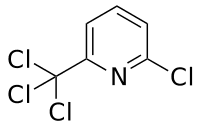Formula C6H3Cl4N | ||
 | ||
Appearance colorless/white crystalline solid | ||
Nitrapyrin is an organic compound with the formula ClC5H3NCCl3. It is a widely used nitrification inhibitor in agriculture as well as a soil bactericide and has been in use since 1974. Nitrapyrin was put up for review by the EPA and deemed safe for use in 2005. Since nitrapyrin is an effective nitrification inhibitor to the bacteria nitrosomonas it has been shown to drastically the reduce NO2 emissions of soil. Nitrapyrin is a white crystalline solid with a sweet odor and is often mixed with anhydrous ammonia for application.
Contents
Synthesis
Nitrapyrin is commonly produced by the photochlorination of 2-methylpyridine:
CH3-C5H4N + 2Cl2 → CCl3-ClC5H3N + 4 HClProduced by DOW Chemical, the product marketed under the trade name N-Serve and contains small amounts (less than 5% wt) of the non-active ingredient 4,6-dichloro-2-trichloromethylpyridine.
Function
Nitrapyrin functions as an inhibitor of the urease enzyme in the nitrifying bacteria Nitrosomonas, preventing hydrolytic action on urea. It is applied to the region of soil and inhibits nitrification for 8–10 weeks. Urease Inhibition specifically prevents the following reaction:
(NH2)2CO + H2O → CO2 + 2NH3
Without this capability Nitrosomonas cannot produce nitrite thus inhibiting nitrification:
2NH4+ + 3O2 → 2NO2− + 2 H2O + 4H+
Degradation/Decomposition
Nitrapyrin decomposes both in soil and in plants. The compound itself tends not to persist in nature. The primary decomposition is the hydrolysis of the trichloromethyl functional group, resulting primarily in 6-chloro-picolinic acid which is the only detected residue in plant metabolisms.
